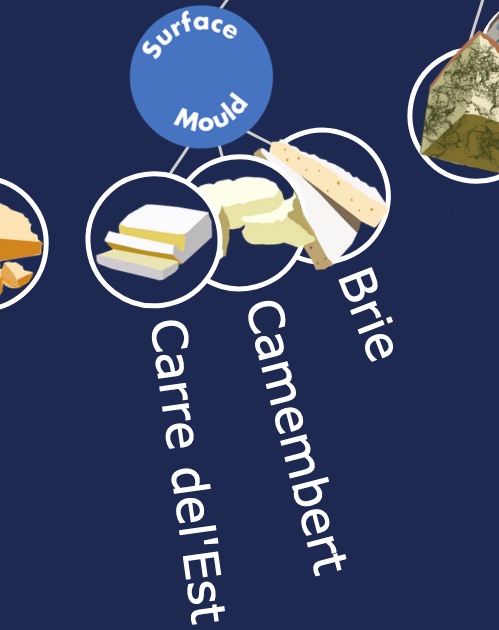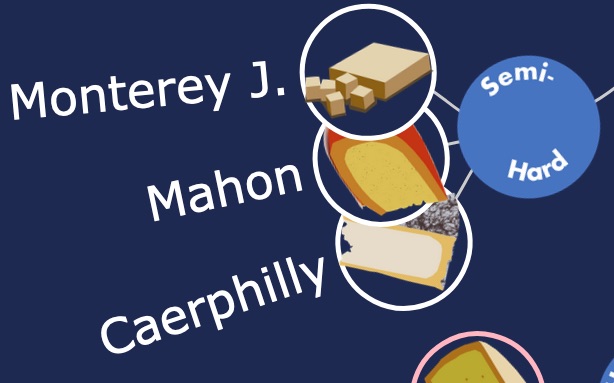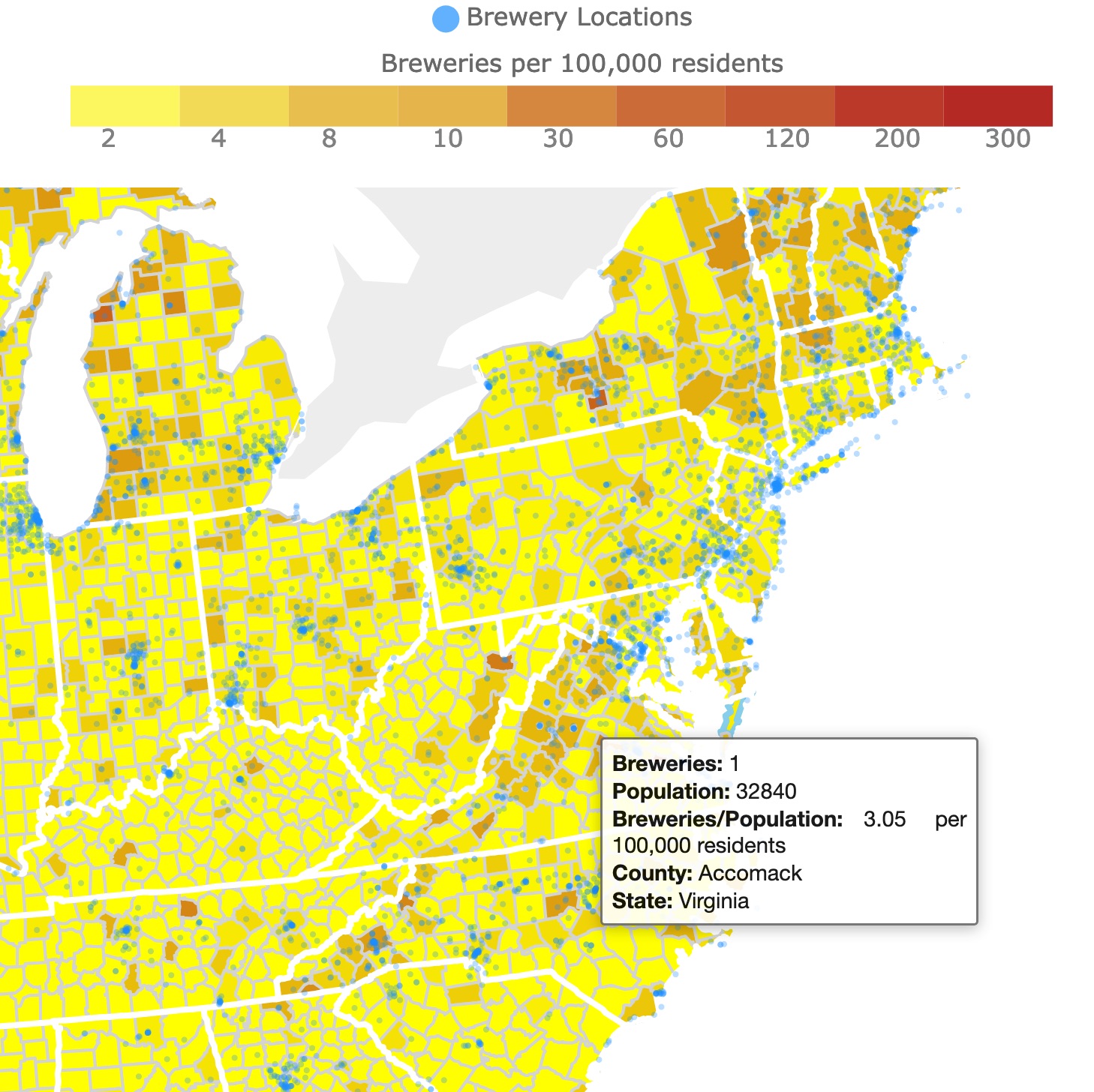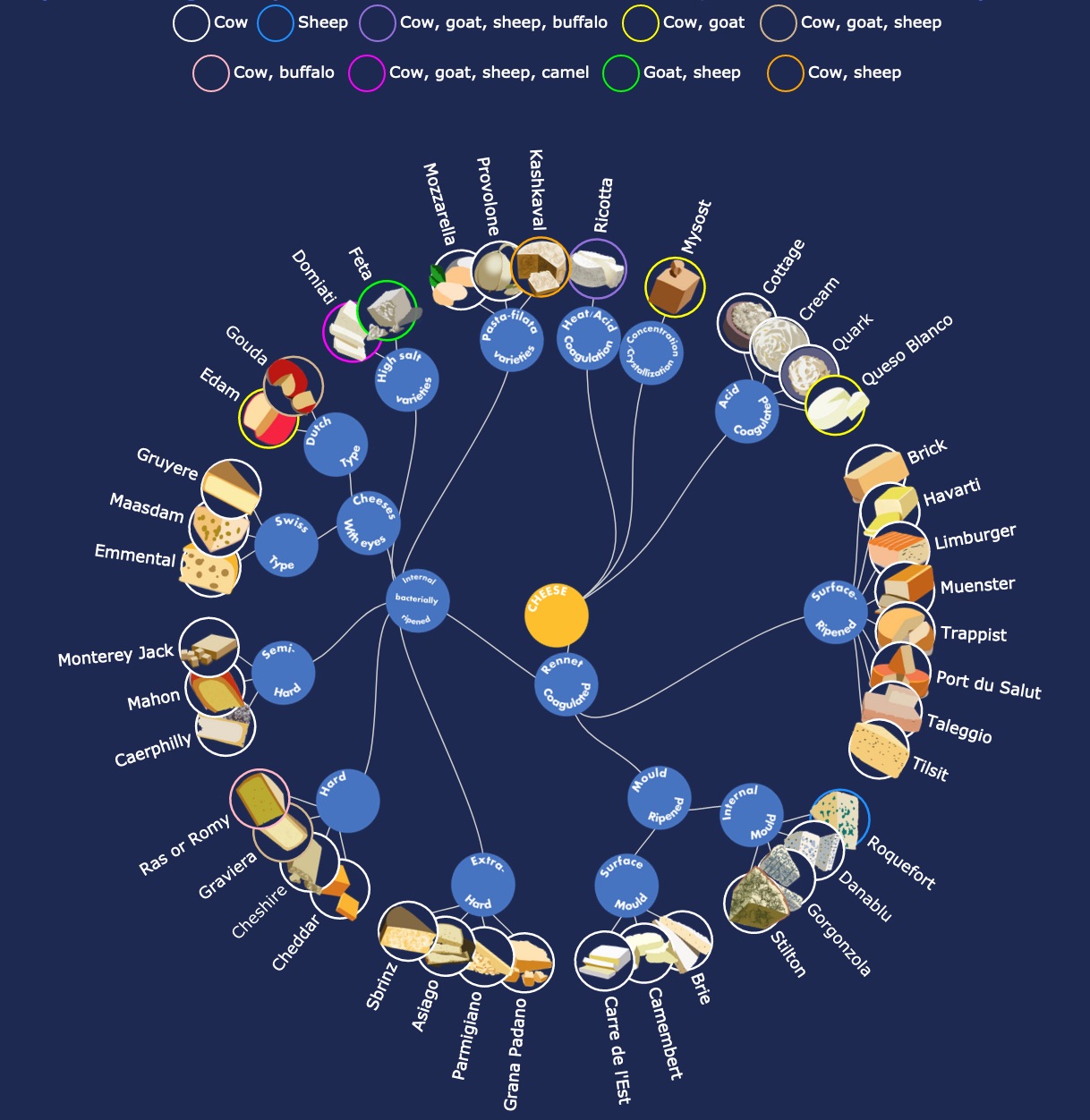Types of Cheese Visualized
This is a radial Dendrogram visualizing the different groups of cheeses originating in the Middle East, Europe, and North America. This graph is based on a graph of cheese varieties found on Fundamentals of Cheese Science by Patrick F. Fox, Timothy P. Guinee, Timothy M. Cogan, Paul L. H. McSweeney. The advantages of this classification is that it includes processes, and types of cheese. As an added bonus this graph includes the animal where the milk comes from. This is achieved by using a colored ring around each cheese variety.
When you hover over each cheese, you will find detailed information about the source, type, rind, aroma, taste, and country of origin. These descriptions should be enough to give you an idea of the result of the process, and decide the cheese you would like to try next time you are in the dairy section.
The blue circles in the middle describe the main process used in making each cheese variety.
There are other ways to classify cheese, for example they can be categorized as natural versus process cheeses, unripened versus ripened and soft, versus hard. Many cheeses are named for their place of origin, such as Cheddar cheese, which originated in Cheddar, England Hilmarcheese.
If you cannot stop thinking about having a cheese in any its forms, I suggest you book a novel dining experience, a cooking class, or a food tour with Eatwith. Eatwith is a culinary experience where you will try delicious foods, meet new people, or learn about cooking. Eatwith is available in different locations, but you can also try new flavors from the comfort of your home. To learn more Click here!
These are the Processes and characteristics and examples of different types of cheese.
Acid Coagulated Cheeses

Acid Coagulated or Fresh Cheese is produced by acid coagulation at 30 - 32°C with little or no added rennet. The addition of an acid ingredient breaks down the micelle structures and reorganizes the proteins into a firm network.
Examples of Cheese produced from acid coagulation are:
- Cottage: This cheese is a fresh cheese not aged of mild flavor. Great to put on fruit, crackers of bread.
- Cream: Soft mild tasting cheese. Great to spread on crackers, bread, or toast.
- Quark: White, soft, mild cheese, unsalted and with no fat. It tastes like Greek Yogurt so it can be used as a salad dressing or mixed with fruit!
- Queso Blanco: White Cheese, mild flavor. It can be used as a top on salads or Mexican dishes. It can also be used as a dip.
Rennet Coagulated Surface Ripened Cheese

Surface-ripened cheeses ripen from their outside surface inward to the interior, via bacteria, yeasts, and/or molds. These organisms are encouraged to grow during the aging process.
A red or orange color develops on the surface of most surface-ripened cheeses during ripening due to the production of carotenoid pigments by bacteria. Via Science Direct.
- Brick: Semi Hard Cheese. At first is sweet but as it matures it turns pungy. It is great with pasta, toasted bread, and potatoes.
- Havarti: has a sharp flavor and buttery aroma. It is a table cheese, great for grilling and melting, also for pasta.
- Limburger: has pungent odor and strong flavor but creamy texture. Used for sandwiches.
- Muenster: flavor mild to sharp. Used in grilled dishes, pasta, and pizza.
- Trappist: traditionally made by monks. Semihard cheese with mild to pungent flavor. Good to eat melted, sliced with fruit or wine.
- Port du Salut: Semi soft cheese made by monks. It has a with a mellow, sweet-and-savory flavor. Served with fruit and crackers or in grilled sandwiches.
- Taleggio: has a mild flavor and fruity tang, but a strong aroma. It goes well with Bruschetta, risotto, polenta, and salads.
- Tilsit: semi-firm texture cheese, ideal for slicing. Good for salads, melted in sauces or on potatoes and burgers.
Internal Mould Ripened Cheese

Also called blue mold Ripened cheeses, have a distinctive blue/green streaks in its interior. The molds used to ripen the cheese are from the genus Penicillium.
- Roquefort: EU law dictates that only cheese aged in Combalou caves of Roquefort may hold this name. This is a moist, and tangy blue cheese. Flavor produced by butyric acid. Usually paired with nuts, dried fruits, crackers or in a salad.
- Danablu: Semisoft, creamy blue veined strong taste cheese. Served with meats and pastas or stews.
- Gorgonzola: It can be buttery or firm, crumbly and quite salty. It is good to eat it with fruits, dry fruits, jams and vegetables.
- Stilton: Crumbly in texture complex and bold flavors. Nutty and salty finish. Served with crackers, bread, mango chutney or wine.
Surface Mould Ripened Cheese

Surface mould–ripened soft cheeses are characterized by the presence of a felt-like coating of white mycelia due to the growth of Penicillium camemberti on the surface. The surface mold plays only a small role in ripening the interior and, to boost the mild and often bland flavor, producers may add extra cream.
- Brie: It is pale in color with a slight grayish tinge under a rind of white mould. Brie is rich, buttery, fruity, and increasingly earthy with age. It has a runny, creamy. Brie is eaten with plain bread or crackers. It can also be cooked into different dishes.
- Camembert: is a moist, creamy, surface-ripened cow's milk cheese. It was first made in the late 18th century at Camembert, Normandy, in northern France. To eat it cut off slices of the cheese and use a knife to spread it on crackers or a slice of French bread.
- Carre de l'Est: From the Lorraine Region, it has a smoky bacon favor.
Internal Bacterially Ripened Extra Hard Cheese

These cheeses are hard and brittle. They are hard because they are low in fat and in moisture. In addition to grating well, they are usually aged up to 3 years to develop a sharp flavor.
- Grana Padano: This hard, crumbly-textured cheese is made with unpasteurized cows' milk that is semi-skimmed. It does well served on a cheese board, ideally accompanied by something sweet, like dates, figs, or a dab of good honey, as it is shaved over pasta.
- Parmigiano Reggiano: is the "king of cheeses". It is allowed to contain only three very simple ingredients: milk (produced in the Parma/Reggio region), salt, and rennet. Parmigiano-Reggiano is commonly grated over pasta dishes, stirred into soups and risottos, and eaten on its own.
- Asiago: is a specialty of Italian regions. Aged Asiago is often grated in salads, soups, pastas, and sauces, while the fresh Asiago is sliced to prepare panini or sandwiches.
- Sbrinz: Sbrinz cheese is a Swiss cheese made from whole, raw cow's milk. It a minimum of 18 months before it can be savored. It has a nutty, spicy, strong, tangy flavor. It is perfect for adding to pasta, risotto or au gratin dishes.
Hard Cheeses

- Cheddar: it is a hard, white sharp tasting natural cheese. If annatto is added, the cheese gets an orange coloring. Cheddar is a versatile cheese. It can be on a casserole, melted into dip on skillet dish or as an appetizer.
- Cheshire: Considered to be one of the finest cheeses ever made in England. Crumbly cheese white in color. Orange color is the result of adding annatto. Milky and tangy flavor. Perfect with fruits, chutney, and vegetable or baked dishes.
- Graviera: One of most popular Greek cheeses. The flavor ranges from slightly sweet and nutty to a bit spicy. Used for cooking, grating, and as a cheese plate.
- Ras or Romy: Is the main traditional hard cheese in Egypt. It has a pungent smell, and different degrees of saltiness depending on the age. It is suitable for grating, the wheels are typically cut into long, thin slices. This shape makes the cheese easy to eat inside a pita.
Semi Hard Cheeses

- Caerphylly: crumbly white cheese that originated in Caerphilly Wales. This cheese is known as "the crumblies". The flavor is citrusy, grassy, mushroomy, salty, and sour. Usually melted into dishes.
- Mahon: It is a soft to hard white cheese. It has a buttery sharp, slightly salty flavor.
- Monterey Jack: American cheese with mild flavor and slight sweetness. Melts easily, can be used to substitute for Parmesan or eaten on its own with crackers.
Swiss Type Cheese

Swiss Type Cheeses or Alpine cheeses were traditionally made in large rounds or "wheels" with a hard rind. Most varieties have few if any holes, or holes that are much smaller than the large holes found in some Emmental or its imitations. The general eating characteristics of the cheeses are a firm but still elastic texture, flavor that is not sharp, acidic or salty, but rather nutty and buttery. When melted, which they often are in cooking, they are "gooey", and "slick, stretchy and runny.
- Gruyere: Made from whole cow's milk and cured for six months or longer. Gruyère is a great table cheese, so it can be eaten in slices, like on a sandwich or as part of a cheese platter.
- Maasdam: Maasdam has internal voids, or holes from the ripening process, and a smooth, yellow rind. If eaten young, it tastes great with a sandwich or as a snack. It can also be melted on casseroles, soups and fondues.
- Emmental: also known as Emmenthaler, Emmenthal or Emmenthaler. Formed with naturally occurring holes. The size of the holes do not affect the flavor. Emmental has mild flavor that is slightly buttery. It cheese melts easily, which makes it perfect for sauces. It also goes well with fruits and notes.
Dutch Type Cheese

They belong to the group of semi-hard cheeses and have undergone maturation for at least four weeks when brought to the market. Gouda-type cheeses, typically in the form of 12-15 kg wheels or blocks, are characterized by a limited number of rather small round eyes. Dutch-type cheeses
- Gouda: mild-flavored, yellow cow's milk cheese originating from the Netherlands. It has a mild, soft, and almost sweet taste and texture. They're best on sandwiches or crackers.
- Edam: is traditionally sold in flat ended spheres with a pale yellow interior and a coat, or rind, of red paraffin wax. Paired with rich fruit (i.e. apricots, peaches and cherries).
High Salt Variety Cheeses
The main reason that cheese makers salt brine their cheese is to slow down or completely stop the bacteria process of converting lactose to lactic acid. A lot of lactose is removed during the process. Salting the cheese also pulls moisture from the surface, properly drying it out for rind development. It also inhibits the growth of a variety of molds, that are attracted to cheese.
- Feta: is a Greek brined curd white cheese made from sheep's milk. It is formed into large blocks, and aged in brine. Feta is used as a table cheese, in salads, and in pastries. It is often served with olive oil. It can also be served cooked (often grilled), as part of a sandwich, in omelettes, and other dishes.
- Domiati: soft white salty cheese made primarily in Egypt. Cheese is often served with breakfast in Egypt, along with bread, jams and olives.
Pasta Filata Varieties

also known as "stretched curd" or "spun paste", refers to the process of heating and stretching curd directly before forming a final cheese. Cheese Science Toolkit
- Mozzarella: Due to its high moisture content, it is traditionally served the day after it is made. It can be kept in brine for up to a week or longer when sold in vacuum-sealed packages. It may be served in restaurants and at the family table as an antipasto, or appetizer, to enjoy with sliced prosciutto, bresaola or salami. Another way is baked on Pizzas!
- Provolone: contains high amounts of calcium, protein and sodium. The cheese goes along with aged red wines. At the table, it could be served with hot chutneys, homemade breads and flat breads.
- Kashkaval: Cheese from eastern Europe, with round, sliceable shape. It has smooth, solid texture, with no holes. This sheep's milk cheese is semihard in texture, and it's especially well-suited for cooking, grating, and melting.
Heat Acid Coagulation
Several cheeses are made worldwide by acid-coagulation of highly heated milk. Popular acid/heat coagulated cheeses include Paneer, and Ricotta. These cheeses are typically made from whole milk, skim milk, cream, whey, or combinations. Ricotta is a soft cheese that has a fine, moist, grainy texture. Ricotta often appears in recipes for lasagna and other Italian casseroles. It's also a common stuffing ingredient for ravioli, manicotti, and other types of pasta. In desserts, it can be used similarly to mascarpone in cheesecake or blended with sugar, spices, and flavorings to fill cannoli or as a layer cake filling.
Concentration Christallyzation
Mysostis a Scandinavian cheese in origin and traditionally made from the whey of cow milk. The color of this cheese is usually light to dark brown, depending on the amount of cream that has been added and the sugar caramelization levels.
Affiliate Disclosure
foodieviz.com is a participant in the Amazon Services LLC Associates Program, an affiliate advertising program designed to provide a means for sites to earn advertising fees by advertising and linking to Amazon.com. foodieviz.com also participates in affiliate programs with Clickbank, CJ, Eatwith, and other sites.
If you are thinking about preparing your own cheese at home, I sugguest these two kits found on Amazon.
- Standing Stone Farms Ultimate Cheese Making Kit: Great to prepare Mozzarella, Feta, Halloumi, Cheddar Cheese Curds, Pepper Jack, Cream Cheese, Marscapone, Chèvre, Burrata and more.
- Standing Stone Farms: Complete Cheese Making Kit
If you just want to buy delicious cheese and try it in different forms I suggest this melter and fondue maker, also found on Amazon.
- YOOYIST Raclette Cheese Melter, this is an Electric Commercial Cheese Machine Swiss Dish Maker Demi Melting Warmer 650 Watt Quick Heating Anti-rusting
- Cuisinart CFO-3SS Electric Fondue Maker, Brushed and Stainless, great for gathering with friends and family.
Cheese Production
Cheese is the result of coagulating or curdling milk, stirring and heating the curd, draining off the whey (the watery part of milk), collecting, and pressing the curd, and in some cases ripening.
Cheese creation is both a science and an art. Cheesemakers rely as much on measurements of pH levels and inoculations of specific molds as they do their own senses of sight, touch, and smell. There are six important steps in cheesemaking according to the The Spruce Eats:
- Acidification: First step in which a starter culture is added to milk that will change lactose (milk sugar) into lactic acid. This changes the acidity level of the milk and begins the process of turning milk from a liquid into a solid.
- Coagulation: is the process of denaturing the milk proteins to form a gel network, this is done by transforming the liquid into a semisolid. When making cheese, an enzyme called rennet is added either as a liquid or paste to further encourage the milk to solidify. Bacterial cultures are added to the milk before coagulation and after pasteurization and determine the flavor and texture of the final cheese product.
- Curds and Whey: After the curds are formed, they’re pressed and drained before different elements are introduced, depending on the type of cheese being made. The liquid that is leftover after the curds are drained is called whey. The custard-like mass is cut into curds that are heated until the ideal firmness is achieved. Large curds cooked at lower temperatures retain more moisture, have less protein bonding, and result in soft cheeses, like ricotta. The opposite is true for small curds, which are cooked at higher temperatures and yield hard cheeses, like Parmesan Food Source Information.
- Salting: Salt may be stirred in with the curds during knitting, applied to the surface during curing, or dissolved in brine in which the curds soak. Salt is added for flavor. It also acts as a preservative so the cheese does not spoil during the long months or years it spends aging and it helps to form a natural rind on the cheese.
- Shaping: In this stage the cheese is given form by placing it in a basket or mold.
- Ripening or curing: This stage is key to the development of a cheese’s characteristic flavor, texture, and aroma. The proper humidity, temperature, and oxygen levels must be maintained for the cheese to age as desired. Curing temperatures range from 35-50°F and humidity levels range from 80-95%. The curing process can take weeks, months, or years depending on the type of cheese. Some cheeses, such as provolone, are aged by the action of bacteria uniformly spread throughout the interior of the body of cheese; these are referred to as interior-ripened cheeses. Some cheeses are aged by a bacteria, mold, or yeast that is applied to the surface of the cheese mass; these cheeses are called surface-ripened Food Source Information.
Resources for Cheese Classification
The code used for this graph was modified from Cluster Dendrogram. The cheeses were drawn using Krita. The information on each individual cheese variety came from Wikipedia and from Cheese.com.
Inspiration for Types of Cheese Visualized
This visualization was created after viewing the graph on Popular Science called "Meet the hard-working microbes that make your favorite cheeses". I was quite intrigued with the different microbes displayed. I have a degree in biology and I found it quite interesting and reminiscent of microbiology classes. So that infographic actually made me think on the science behind the process. I definitely spent some time looking at it. But it was hard to group each variety with a specific organism.
I decided I wanted a more detailed graph. One that gave me more information on each cheese. I found that the source of milk is of major interest, but does not seem to be that important when it comes to classifying cheese. Besides, most of the varieties use just cow milk. The main characteristic used to catalogue cheese, are the physical characteristics. But after looking at a few catalogues, they don't seem to make much sense. Fundamentals of cheese provided the most comprehensive organization. There is a physical component, a microbiological component, and the process to produce the cheese.
I am not a connoisseur of cheese but it was particularly encouraging to find I had tried at least one cheese in most of the groups. It also made a lot of sense to find that cottage and cream cheese had a similar appearance and flavor and went through the same basic process. Also that surface ripened cheeses had a similar look and coloring. Furthermore, it was not surprising that Roquefort was produced from internal mold, or that Brie and Camembert had surface mold that gave it a soft white exterior and light color.
I excuse myself for not including Colombian trademarks such as Queso Campesino and Queso Costeño. I also wanted to include delicacies like Halloumi but the screen has a limited space, and I wanted to focus in the most common cheese varieties.
This was not an easy graph to complete. I had constant cravings of Roquefort, Cheddar, and Camembert. Reminiscences of Emmental and Gruyere. Good thing we make quesadillas at home at least once a week. Is there anything better than CHEESE?
Made by Luz K. Molina with D3.js.








